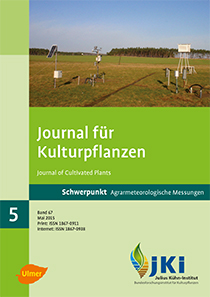Trial field Dahnsdorf – 15 years of agrometeorological measurements Part 2: Air temperature
Keywords:
Fluctuation, normal value, trial field, temperature, warmingAbstract
For the considered period from between 1998 and 2012, the mean air temperature values at the trial field Dahnsdorf amounted to 9.5°C and were therefore well above (+0.8 K) the currently valid normal value of the normal period 1961/90 measured at the DWD weather station Wittenberg. Compared to the normal period, no month of the aggregate Dahnsdorf measurement period was colder. The differences ranged between 0.0 K (June, October) and +1.6 K (January). Especially the period between January and April showed a distinct warming (+1.0 to +1.6 K). The monthly mean air temperatures varied considerably between the individual years, in particular in January (10.5 K) and December (10.2 K).
The means of the daily mean air temperature per calendar day were also mostly increasing from 1998 to 2012. 262 out of 366 days were warmer compared to the normal period. Considering, however, the annual variation of differences to the normal period values, there were also colder periods. This applies for instance to the period from 6th to 20th October, which was 1.2 K colder compared to the same period at the DWD weather station in Wittenberg.
The range of daily mean air temperatures of a calendar day depends functionally on the date: wide range (partially > 25 K) in winter, low range (partially < 10 K) in summer.
The monthly distributions of 10-minute mean air temperatures allow similar conclusions: Extreme ranges in winter (February: 40.0 K), lower ranges in summer. In winter, negative differences on the monthly mean are more frequent and greater. In summer, positive differences on the monthly mean are more frequent and greater.
The number of days exceeding or falling below defined thresholds increased at the experimental field in Dahnsdorf. This was observed for summer days (max. ≥ 25.0°C) and hot days (max. ≥ 30.0°C) as well as for freezing days (min. < 0.0°C) and ice days (max. < 0.0°C). The last one is contrary to the long term trends of the period 1951–2010.
Air temperature varies with the measuring height. The monthly means vary only slightly between 2.0 m and 1.0 m (from + 0.1 K to + 0.2 K). They are, however, greater at 2.0 m and 0.2 m (from + 0.6 K to + 0.9 K). At these heights, the temperature differences during the day and night periods vary distinctly between 2.0 m and 0.2 m: In the night lower air temperature at ground level, in the day lower values at 2.0 m height.
DOI: 10.5073/JfK.2015.05.02, https://doi.org/10.5073/JfK.2015.05.02
Downloads
Published
Issue
Section
License
The content of the journal is licensed under the Creative Commons Attribution 4.0 License. Any user is free to share and adapt (remix, transform, build upon) the content as long as the original publication is attributed (authors, title, year, journal, issue, pages).
The copyright of the published work remains with the authors. The authors grant the Journal of Cultivated Plants, the Julius Kühn-Institut and the OpenAgrar repository the non-exclusive right to distribute and exploit the work.







